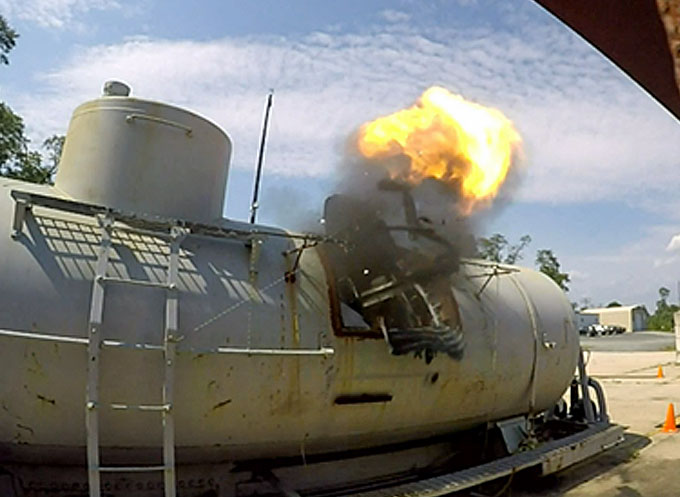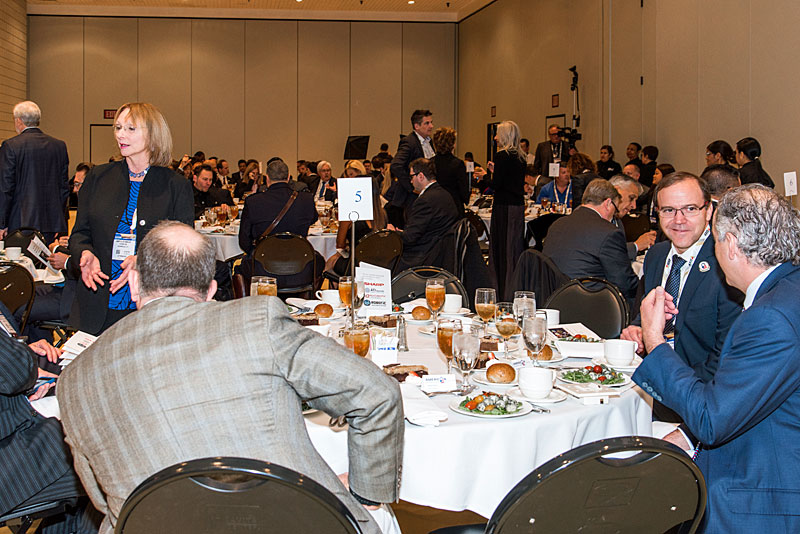
Each day, more than twenty-six thousand commercial flights transport passengers and cargo to destinations around the world.
Several U.S. government agencies work together to secure these flights, including the Department of Homeland Security (DHS) Science and Technology Directorate (S&T).
S&T’s Commercial Aircraft Vulnerability and Mitigation (CAVM) program, part of the Homeland Security Advanced Research Projects Agency Explosives Division (HSARPA), supports testing and evaluation efforts to assess potential vulnerabilities and evaluate countermeasures that can mitigate the impact of explosives on commercial aircraft.
The DHS S&T Homeland Security Advanced Research Projects Agency was recently recognized by American Security Today as a 2017 ‘ASTORS’ Platinum Award Winner for Excellence in Homeland Security at ISC East.
Recently, CAVM partnered with the Federal Aviation Administration (FAA) and U.S. Army Aberdeen Test Center (ATC) to develop a reusable Aircraft Explosive Testing Simulator that facilitates the explosive testing of new generation commercial aircraft.
The majority of current commercial aircraft have aluminum fuselages, and CAVM has conducted a significant amount of explosive vulnerability testing on a wide range of those aircraft types.
However, newer generations of commercial aircraft fuselages are being made with composite materials, such as carbon fiber reinforced plastic.
Understanding the potential vulnerability of composite aircraft to explosives requires testing, but the new generation composite aircraft fuselages are less available and more expensive than legacy aluminum fuselage structures.

This made it essential to develop a sustainable and representative testing solution so evaluations of new composite aircraft structures to explosive-based threats could continue as needed.
“The lack of availability of new generation composite commercial aircraft structures for use in destructive explosive testing necessitated development of alternate test methods and tools,” said Nelson Carey, CAVM Program Manager.
“Doing so is essential to provide S&T and its U.S. government customers with accurate and efficient methods for conducting commercial aircraft explosive vulnerability assessments.”
Based on this need, ATC developed the Aircraft Explosive Testing Simulator that could be used for repeated explosive testing.
The simulator consists of a steel cylinder that can be pressurized to simulate conditions of an in-flight aircraft.
The cylinder has an opening where composite test panels are installed and subjected to testing for a variety of explosive threat scenarios.
The composite aircraft test panels are provided through an interagency agreement with the Federal Aviation Administration (FAA) and the National Institute for Aviation Research, an FAA Center of Excellence.
“Interagency cooperation in support of CAVM efforts is essential for extending limited resources and insuring a maximum rate of return on research and development investment,” Carey said.

During a test, evaluators place an explosive threat inside the simulator, which is then pressurized to simulate airline operational flight profiles.
Once the explosive is detonated, instrumentation gathers data on internal and external pressure resulting from the blast, and high speed video instruments gather information on the panel’s physical condition, looking for any deformation, breach, or crack growth.
Aircraft vulnerability experts from S&T’s Transportation Security Laboratory then conduct a post-blast inspection and analysis to determine the structural response of the composite test panel to the specific explosive threat condition.
Finally, evaluators remove the panel from the simulator and install a new one in its place, allowing for multiple tests to be conducted within a short time period.
“The Aircraft Explosive Testing Simulator provides a rapid, reconfigurable and cost effective tool for acquiring test data on composite aircraft structural response to internal explosive threats,” Carey explains, highlighting the impact the tool has on testing efforts.
Not only does the Aircraft Explosive Testing Simulator help S&T develop a better understanding of how explosives affect composite commercial aircraft, it also allows experts to compare results with previous tests on aluminum structures.
CAVM researchers will use the data to learn about composite-based commercial aircraft structure vulnerability to terrorist-based internal explosive threats.
This research supports the Transportation Security Administration’s sponsor requirements to investigate the vulnerability of new generation composite construction commercial aircraft to internal explosive threats.
(Learn More. Former Homeland Security Secretary John Kelly announced new global aviation security measures regarding overseas airports that have direct flights to the United States. Courtesy of PBS NewsHour and YouTube. Posted on Jun 28, 2017)
S&T is already sharing its findings from the simulator with other government partners.
The Department of Defense’s (DoD) U.S. Army Research Laboratory is using the data to develop numerical analysis models and tools to help simulate composite structure response for different and more complex threat scenarios.
Additionally, CAVM recently hosted a round of tests with TSA, FAA, DoD, TSL, and the French government’s Alternative Energies and Atomic Energy Commission (CEA).
The event was part of an international effort to strengthen aviation security by bringing together officials from around to globe to share findings and discuss shared goals.
The Aircraft Explosive Testing Simulator is the latest S&T-funded technology that will help enhance the nation’s aviation security.
As threats continue to evolve, it is crucial to have tools that can efficiently gather accurate data on potential vulnerabilities and the countermeasures employed to overcome them.
The 2017 ‘ASTORS’ Homeland Security Awards Program
 The U.S. Department of Homeland Security Science (DHS) and Technology Directorate (S&T) was recognized last week with four ‘ASTORS’ ‘Excellence in Homeland Security’ Platinum Awards by American Security Today (AST), at the ISC East Conference in New York City to honor organizations that are actively addressing today’s evolving Homeland Security challenges in innovative ways.
The U.S. Department of Homeland Security Science (DHS) and Technology Directorate (S&T) was recognized last week with four ‘ASTORS’ ‘Excellence in Homeland Security’ Platinum Awards by American Security Today (AST), at the ISC East Conference in New York City to honor organizations that are actively addressing today’s evolving Homeland Security challenges in innovative ways.
This awards program was organized by AST to recognize the most distinguished security vendors, as the nation continues to respond to escalating threats from home and abroad.

The innovative solutions being implemented to meet those threats has led to tremendous growth in the field of Homeland Security, and to this awards program for recognition of the key contributors to our nation’s security.
-
Department of Homeland Security (DHS) Science and Technology Directorate (S&T)
- Enhanced Dynamic Geo-Social Environ (EDGE) Virtual Online Training for First Responders Open at No Cost to All U.S. First Responders Agencies, Across Disciplines for Coordinated Response to Critical Incidents
- Excellence in Homeland Security
-
Department of Homeland Security (DHS) Science and Technology Directorate (S&T)
- Resilient Tunnel Plug (RTP) to Strengthen Mass Transportation Critical Infrastructure from Disruptive Flood Events
- Excellence in Homeland Security
-
Department of Homeland Security (DHS) Science and Technology Directorate (S&T) First Responders Group (FRG)
- Flood Apex Program, Applying New & Emerging Technologies to Improve Community Resilience from Flood Disasters, Reduce Fatalities and Property Loss
- Excellence in Homeland Security
-
Department of Homeland Security (DHS) Science and Technology Directorate (S&T) Homeland Security Advanced Research Projects (HSARPA)
- Surface Transportation Explosives Threat Detection (STETD) on Developing the Capacity to Detect Potential Threat Items Throughout Rail and Subway Systems Without Alerting the Subject or Negatively Impacting the Speed of Travel
- Excellence in Homeland Security
Over 100 security professionals gathered from across North America and the Middle East to be honored from disciplines across the Security Industry in their respective fields which included:
- The Department of Homeland Security
- The Department of Justice
- The Security Exchange Commission
- State and Municipal Law Enforcement Agencies, and
- Leaders in Private Security
Recognized for their Innovative Training and Education Programs, Outstanding Product Development Achievements and Exciting New Technologies to address the growing Homeland Security Threats our Nation is facing.
American Security Today was formed after careful reflection of 9/11 and its aftermath when the Department of Homeland Security was established and there was an immediate explosion of new products and solutions for what was perceived as an imminent second attack on primary targets in the United States.
As time moved forward from 9/11 itself and in recent years, the threats to our nation have evolved from a large scale 9/11 type attack to:
- Domestic and International Terrorist Attacks carried out by ‘lone wolves’ and coordinated individuals
- Cybersecurity breach attacks against our government agencies, financial institutions and critical infrastructure facilities
- Unprecedented urban violence
- Cultural shifts and societal media bias, which make it increasingly difficult to secure our nation in this constantly evolving threat environment.
These current circumstances have put forward another rapid expansion of new ideas, products and solutions to combat these ever changing challenges.

These changes have called for a new generation of security experts in the Homeland Security and Public Safety fields who need real time knowledge of our ever growing threats.
These experts include the Government at the Federal, State and Local levels as well as from Private Firms specializing in Physical Security, Port Security, Law Enforcement, First Responders, Military and Private Security responsible for implementing coordinated security measures to ensure our Nation’s Security and improve Public Safety.
Together, each of these entities work together seamlessly on the front lines of protecting our communities, to ‘Keep our Nation Secure, One City at a Time.’


















